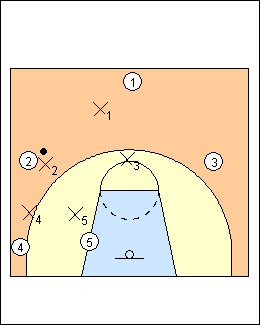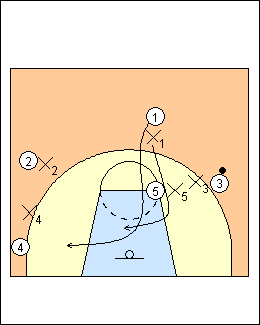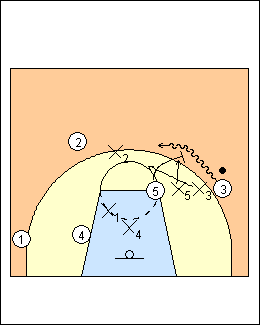 | 1 Bob Huggins "Box theory" - get the ball on one side and keep it there. Pick the ball up at halfcourt to keep it out of the "chute", a fullcourt lane between the elbows. Contain the ball, dribble penetration is how most teams score. Never allow a straight-line (direct or shooting) pass, make them pass over, under, and around you, not through you. All defenders are directly between the ball and their man, up the line in a closed stance (even post defenders, no wrestling match). They don't use flat triangles, deny defenders need to turn their head back and forth to see ball, man. X2 and X3 are not really denying the wing-entry pass, just pushing it out so it has to be going away from the basket, making the passing lanes longer. |
 | 2 With the ball on the wing, deny penetrating and reversal passes. There is help if you get beat backdoor. Help defenders are on the midline (closed stance). On a pass, defenders turn and sprint, don't slide. Force the ballhandler baseline without allowing a drive to the basket. On baseline penetration, help by a post defender may force a hard shot, but a guard has to drop and box out a big. Instead, have that guard help on the penetration, leaving the post defender to rebound. Trappers lock legs (can't get split) with high hands, chests out, butts down (don't stand up). Read where the ballhandler's lead shoulder is pointed. The 3-point shot and shot clock changed the game. On dribble penetration, help and recover used to be line of the ball, getting as deep as the ball, which allowed a direct kick-out pass but for a lower-percentage outside shot. However, now that shot is for 3 points, so help is in line with ball and man, not allowing a direct pass. |
 | 3 To defend a backcut, snap your head and throw the leg towards the basket, don't turn and chase. Screens Defend a UCLA cut by going between the screener and xscreener. On a backscreen, snap your head, find and meet the screen (arm out, hand into his chest), then step through inside (ballside). On a cross-screen, the xscreener jams the cutter if he comes high, helping xcutter, who leads the cutter to the ball. If the cutter goes low, xcutter snaps his head, also goes under the screen, and ends up high side. On a downscreen, don't chase, the cutter will curl. Gap instead (third man through), then chase over or under the screen if the cutter fades. |
 | 4 Ballscreens If xscreener can re-route the screen above the arc, then squeeze (shown) or gap. If the screen is inside the arc, trap, or show and go over. X4 absorbs the roll on a trap. |
This page was made with Basketball playbook from Jes-Soft